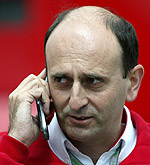 When did you start on the V8 project?
When did you start on the V8 project?
Luca Marmorini, Toyota Technical Director, Engine: "The front end is a development of what we did with
"When we had to decide our plan for the V8 we wanted to be able to test the engine in the car before the 2005 summer break. That was our target. Typically when you have a brand new engine you need roughly eight months for design and production and a further four months of development on the dyno. So eight months before February 2005, the planned date for the first dyno test, we started the design of the engine. After a while the FIA changed some dimensional constraints in the regulations, so we had to adapt our design around a fixed bore spacing, crankshaft height and some limitations like this. We had to start again, and instead of February, we moved to March. On 21 March, we fired it up."
How did the first track tests go?
LM: "The first engine went in the interim car in July in Jerez. At the time we had to respect the agreement that said we could not run with more than two cars, so the V8 could only run when one of the V10 cars stopped. There was not a lot of time, but it was enough for us to do some tests and learn. We covered something like 1000kms over several days. It was just a very quick test, but we could already do some modifications during the August test ban, and we went back at the end of September with the first step, and we ran again for two days. Then there was the October ban, and at the end of November we were ready with what we called a raceable version of the engine."
How much has been carried over from the V10?
LM: "As a philosophy we decided not to modify any working parts from the V10 unless it brought a clear performance benefit, or was an important modification. The 2.4-litre has the same unit displacement, so we carried over most of the internal parts. Some parts even have the same drawings as the V10. In this way we could focus on the new things of the V8, which means the dynamic behaviour. Toyota has a lot of experience in V8s from the USA, but we had not revved a V8 to 19,000rpm, so we had to focus on the new challenges. I think that was the right decision. If we had at the same time too many unknowns, including some problems we could have avoided, we could have compromised our development. If you could open the V8 and open the V10 and see them close you will understand that they've come from the same group of people, the same know-how."
What has changed most since that test in July?
LM: "All the hydraulic system, the installation in the car, was done according to our experience with the V10. At that very first test in July we had big problems with the car systems because of this new vibrating machine. If the hydraulics start to fail, then you cannot use the throttle, so we had to modify everything. The V10 also vibrated, but our system was tuned to a certain level. The V8 was different, and we had to adjust mountings and so on. When we ran the TF106 in November we didn't have a single stop due to the engine installation, so we could focus on engine reliability and performance. On top of this the engine used in July was an engine that could not fit the 2006 car, so we had to apply some minor modifications to fit the new gearbox. But it's the same engine in terms of key components and internal parts."
For the first time there's a minimum weight regulation of 95kgs. How did you adjust to that constraint?
LM: "Let's put it this way. If you weighed the engine that ran on the dyno in March 2005, it was much more of a Formula 1 engine than the engine we're running now, in terms of weight. The internal parts are the same, but the one that ran in March was done with 2005 technology, thin wall castings and so on, so it was very light. To give you an example, the V10 we raced in 2005 could not fulfil the new regulations for the V8! So we had to add weight. We put material on castings, as there's no chance now to have thin wall castings where we don't need them. At the same time we integrated the functions of the engine to be sure that we could also collect weight for functional parts."
How closely have you worked with the chassis team?
LM: "An F1 engine is a part of the car. An engine is not good if it's not well introduced into the car. You never win in this way. When we start a new engine we are sitting with the chassis people, and a lot of the input on the specifications of the new engine have come from chassis. Chassis design also takes into account the engine's working conditions. We've done a lot of modifications of the engine, trying to help the car. The engine is a big spacer, and the exhausts are a big volume, around which the aero people have to design a good car. So we are always in contact with them to try to help them design a better car, and at the same time we have to design a car that is cooling enough. Doing everything under the same roof is a huge benefit."

 When did you start on the V8 project?
When did you start on the V8 project?


















